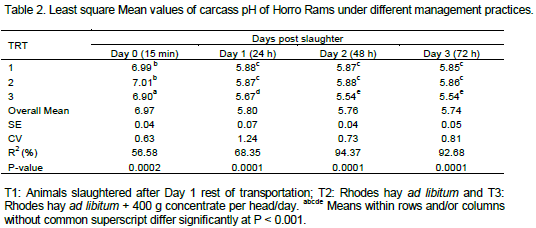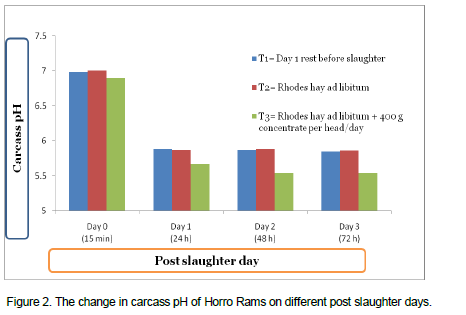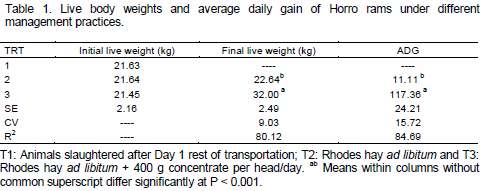ABSTRACT
This study was conducted to evaluate and determine the carcass pH and color of Horro rams under different management practices at Ambo University. A total of 24 Horro rams were randomly assigned to the following three treatments: T1 (Day 1 rest before slaughter), T2 (Rhodes hay ad libitum) and T3 (Rhodes hay ad libitum + 400 g concentrate per head/day). Carcass pH was determined at 15 min, 24, 48, and 72 h post slaughter using pH Meter. Data were analyzed using the General linear model procedures of Statistical Analysis System Software 9.2 (SAS, 2009). The ultimate carcass pH of concentrate supplemented Horro rams (pH24 = 5.67) was lower (P < 0.001) than rams fed on Rhodes hay ad libitum and animals slaughtered immediately after day 1 rest of transportation to experimental site (5.88, and 5.87, respectively). The majority of sensory panelists (> 62%) reported that carcass color was bright red for supplemented Horro rams and red color for those fed on Rhodes hay ad libitum and slaughtered immediately after one day rest of transportation. Carcass darkness/discoloration was not observed up to four days post slaughter from values of carcass pH, color estimation of this experiment and from comparisons of carcass pH measures with values in the literatures. Concentrate supplementation had significant and positive influence on carcasses pH and color of Horro rams. This study disproved the dispute or claim about the problem of early darkening of carcasses of highland animals. Thus, management practices like optimum feeding along sufficient rest after transportation would improve the carcass pH and color.
Key words: Carcass, pH, color, concentrate, Horro lambs.
In Ethiopia, sheep population is estimated at 25.5 million (CSA, 2013). But, their productivity is low due to feed shortage, diseases, lack of animal welfare and inadequate market information. Based on customer feedback or anecdotal evidence, personnel of many abattoirs in Ethiopia exporting small ruminant carcasses to markets in the Middle East have stated that carcass shelf-life is shorter for animals from highland than lowland areas. Furthermore, it is claimed that the problem of early darkening of carcasses of highland animals exists for both sheep and goats (Girma et al., 2010). Goat and sheep carcasses from highland areas of Ethiopia may darken more quickly compared with lowland areas, and 1 or 2 days of rest before slaughter can increase lightness of the surface of goat carcasses. Carcasses of goats and sheep from the highland area were darker than those from the lowland area (Girma et al., 2010). In this regard, Merera et al. (2010) suggested that in some instances commercial animal harvest might occur with rest of less than one day, which could prevent recovery from stress such as replenishment of muscle glycogen.
There is a huge loss of earning foreign income and some attempts have been made to investigate carcass darkening of few goat and sheep breeds (Ameha, 2008; Girma et al., 2010; Merera et al., 2010). But, this 'defect' has not been well investigated. Above all, there is no information on carcass pH and color of Horro sheep. The most carcass color that has been preferred is bright or red and the universal acceptable meat pH ranges from 5.5-5.9. Thus, it is timely and an urgent needs to properly investigate and understand the mutton color and pH of Horro sheep.
Thus, the objectives of this study were:
1. To evaluate and determine the carcass pH and color of Horro rams under different management practices at Ambo University;
2. To generate adequate information for sheep producers, mutton exporters and importers.
Location and facilities of experimental site
The study was conducted at Ambo University sheep farm, which is approximately 115 km west of Addis Ababa, Ethiopia. Slaughter and associated measurements were performed at facilities of Animal Sciences Laboratory of the Ambo University. Rest and feeding of animals took place at sheep feedlot facility of the University.
Experimental animals and treatments
Horro sheep are the long fat tailed highland sheep mainly found in Horro Guduru zone of western Ethiopia. Horro rams with approximately similar age (1 year) and average initial body weight (21.31 ± 2.16 kg) and conformation were purchased from ‘Gabaa Sanbataa’ market found in Horro district of the Horro Guduru zone, approximately 190 km from Ambo University. Animals were transported as procedures for procurement, transportation and handling the once used by abattoirs in Ethiopia. A total of 24 Horro rams were randomly assigned to the following three treatments with 8 replicates. The treatments were Day 1 rest after transportation from local market to Ambo University and before slaughter (T1), Rhodes hay ad libitum (T2) and Rhodes hay ad libitum + 400 g concentrate per head/day (T3).
Horro rams randomly assigned for 90 days fattening treatments were drenched with an anthelmintic (half doze Albendazole) and sprayed with diazinon for external parasites. There was no health problem encountered during the experiment period. The composition of concentrate is 49.5% noug (Guizotia abyssinica) cake, 49.5% ground maize grain and 1% salt (Solomon et al., 1991). Water and moderate quality grass hay provided ad libitum for all treatments until slaughter approximately 12:00 h the day preceding slaughter.
Measurements
The initial, fortnight and slaughter live body weight were taken at the initial, fortnightly and at the end of the feeding trial. The experimental animals were slaughtered after one day rest of arrival at experimental site and at the end of 3 months fattening period. Carcass pH was determined at 15 min, 24, 48, and 72 h post slaughter using pH Meter. The loin cut was chilled at 4°C for the preservation of the carcass in the refrigerator. Muscle pH was measured with a handheld pH meter (Model IQ150; IQ Scientific Instruments, Inc., Carlsbad, CA, USA) in both longissimus dorsi muscles after trimming the surface fat in the area of pH measurement, with duplicate readings, at 15 min, 24, 48 and 72 h after slaughter (Figure 1).

After pH was measured on the day of harvest, a loin was cut between the 11th and 13th ribs to expose the surface of longissimus dorsi muscle. Following a 15-min ‘bloom’ time, subjective color estimations were made by trained sensory panelists. Then carcass color was assessed subjectively using 5 point scale (1=light/bright, 2=Light red, 3=red, 4=dark red, and 5=dark). At 0, 1, 2, and 3 days post-slaughter, the same color estimations were made on the surface of loin cuts.
Statistical analysis
Data were analyzed using the General linear model procedures of Statistical Analysis System Software 9.2 (SAS, 2009). During analysis, treatment was considered as independent variable whereas average daily weight gain, carcass pH and color considered as dependent variables. Means were separated by least significant difference (LSD).
Growth performance of Horro rams
Concentrate supplementation had significant effect on average daily weight gain (ADG) and as expected, the ADG was greater (P < 0.001) for the supplemented Horro rams compared to animals fed Rhodes hay ad libitum (Table 1). The change in live body weight/growth curve was substantially increased up to 30 days fattening duration and then after increased slightly which could be explained as compensatory growth in the first days of fattening periods.
The ADG of concentrate supplemented Horro rams obtained in this experiment (117.36 g/day) was greater than the ADG reported by previous studies of Ewnetu et al. (2006) and Kassahun (2000), who reported 47.3 and 70.9 g/day per animal for Horro male lambs, respectively. In line with this result, the previous study reported that daily live weight gains were greater (P < 0.05) for Horro ewe lambs supplemented with Leucaena pallida and concentrate compared with the un-supplemented treatment (Chala et al., 2013).
Carcass pH and color
Concentrate supplementation had significant positive influence on carcass pH (Table 2). The carcass pH of concentrate supplemented Horro rams was lower (P < 0.001) than rams fed on Rhodes hay ad libitum and those slaughtered immediately after Day 1 rest of transportation to experiment site. For all treatments, carcass pH was appreciably decreased (P < 0.001) from day 0 to 1 and for concentrate supplemented treatment (Table 2 and Figure 2). The ultimate pH values observed on Day 1 post slaughter indicate that there was adequate muscle glycogen in the mutton of sheep with all treatments for production of normal lactic acid levels. Ultimate carcass pH (24 h post slaughter) values obtained from this study were within the international acceptable range of meat pH (5.5-5.9) for export/import market, indicating the glycogen levels in the muscle of the mutton was high enough to develop optimum level of lactic acid causing a fall in pH and thereby improving the shelf life of the mutton.


The results of this study are in agreement with the previous findings, who reported that the pH values found could be considered within the normal pH range, between 5.5 and 5.9 when the pH measurement was made 24 h after slaughter (Teixeira et al., 2005). The pH values, particularly the values obtained 24 h after slaughter, could be considered according to earlier recommendation, within the normal pH range assuming that an ultimate pH value greater than 5.9 is regarded as undesirable (Devine et al., 1993). The longissimus muscle ultimate pH tended to be higher for the grass lambs (pH24=5.62) compared to the stall lambs (pH24=5.57) (Priolo et al., 2002). High-energy diets protect animals from potentially glycogen-depleting stressors has been reported by Immonen et al. (2000). In general, the pH values on Day 0, 1, 2, and 3 post slaughter for all treatments were within the acceptable range of meat pH and comparable with several findings (Archimede et al., 2008; Hoffman et al., 2003; Johnson et al., 2005; Scerra et al., 2001; Teixeira et al., 2005).
As for carcass pH, concentrate supplementation had improved the redness color of carcass from Horro rams (Table 3). The majority of sensory panelists (> 62%) reported that carcass color of Horro rams was bright red for supplemented animals and red for animals fed on Rhodes hay ad libitum and slaughtered immediately after Day 1 rest of arrival/transportation to experiment site.

The current finding was in agreement with the previous study, who reported that feeding for 4 weeks before slaughter increased (P < 0.05) surface carcass lightness (L*=39.2) on day 3 post slaughter regardless of species and origin of goats and sheep (Girma et al., 2010). They were also reported that surface carcass redness (a*) on Day 3 post-slaughter was greater for sheep than for goats, indicating a greater degree of redness for sheep. All correlations between pH of the longissimus dorsi muscle at 24 h post-slaughter and color measures for the carcass surface on Day 3 were significant (P < 0.05). Similarly, meat from grass-fed lambs was darker (P < 0.05) in color (lower L*=46.1) than meat from stall animals (L*=49.23) up to 24 h of display and meat from stall fed animals was more tender and juicier than meat from grass-fed animals (P < 0.01) (Priolo et al., 2002). They also reported meat lightness (L*) was positively correlated with 6 days display for stall-fed lambs. In agreement to the above results, researchers revealed that the difference in meat lightness could have been partially caused by the slight difference in the ultimate pH since high pH meat tend to have a darker color, although meat from stall lambs had a significantly higher fat content than in grass lambs (Ledward et al., 1986).
In general, from this study, carcass darkness/discoloration was not observed up to four days post slaughter and from values of carcass pH and color estimation of this experiment. There was no evidence of short shelf life or early darkening carcasses of Horro rams. In addition to this, carcass darkening was not detected from comparisons of carcass pH measures with values in the literatures. Therefore, this study disproved the dispute or claim about the problem of early darkening of carcasses of highland animals.
CONCLUSIONS AND RECOMMENDATIONS
The study was conducted to evaluate and determine the carcass pH and color of Horro rams under different management practices at Ambo University. The ultimate carcass pH of concentrate supplemented Horro rams (pH24=5.67) was lower (P < 0.001) than rams fed on Rhodes hay ad libitum and animals slaughtered immediately after Day 1 rest of transportation to experimental site (pH24=5.88, and 5.87, respectively). The majority of sensory panelists (> 62%) reported that carcass color was bright red for supplemented Horro rams and red for animals fed on Rhodes hay ad libitum and slaughtered immediately after one day rest. Carcass darkness/discoloration was not observed up to four days post slaughter from values of carcass pH, color estimation of this experiment and from comparisons of carcass pH measures with values in the literatures. Concentrate supplementation had significant and positive influence on carcasses pH and color of Horro rams. This study disproved the dispute or claim about the problem of early darkening of carcasses of highland animals. Thus, management practices like optimum feeding along sufficient rest after transportation would be provided to improve the quality and yield of mutton.
The author(s) have not declared any conflict of interest.
The authors would like to express thanks to Ambo University for financial and logistic support.
REFERENCES
|
Archimède H, Pellonde P, Despois P, Etienne T, Alexandre G (2008). Growth performances and carcass traits of Ovin Martinik lambs fed various ratios of tropical forage to concentrate under intensive conditions. Small Ruminant Res. 75:162-170. |
|
|
|
Chala M, Temesgen A, Tegegn G (2013). Effect of feeding Leucaena pallida with concentrate and antihelmentic treatment on growth performance and nematode parasite infestation of Horro ewe lambs in Ethiopia. Int. J. Livestock Prod. 10:155-160. |
|
|
|
CSA (Central Statistical Authority) (2013). Ethiopian Agricultural Sample Survey. Report on Livestock and its characteristics. April 2013, Addis Ababa, Ethiopia. P. 12. |
|
|
|
Devine CE, Graafhuis PH, Muir PD, Chrystall BB (1993). The effect of growth rate and ultimate pH on meat quality of lambs. Meat Sci. 35: 63–77. |
|
|
|
Ewnetu E, Alemu Y, Rege JEO (2006). Slaughter characteristics of Menz and Horro sheep. Small Ruminant Res. 64(2):10-15. |
|
|
|
Girma A, Kannan G, Goetsch AL (2010). Effects of small ruminant species and origin (highland and lowland) and length of rest and feeding period on harvest measurements in Ethiopia. Afr. J. Agric. Res. 5(9):834-847. |
|
|
|
Hoffman LC, Muller M, Cloete SWP, Schmidt D (2003). Comparison of six crossbred lamb types: Sensory, physical and nutritional meat quality characteristics. Meat Sci. 65:1265–1274. |
|
|
|
Immonen K, Ruusunen M, Hissa K, Puolanne E (2000). Bovine muscle glycogen concentration in relation to finishing diet, slaughter, and ultimate pH. Meat Sci. 55:25-31. |
|
|
|
Johnson PL, Purchas RW, McEwan JC, Blair HT (2005). Carcass composition and meat quality differences between pasture-reared ewe and ram lambs. Meat Sci. 71:383-391. |
|
|
|
Kassahun A (2000). Comparative performance evaluation of Horro and Menz sheep of Ethiopia under grazing and intensive feeding conditions. Ph.D Thesis. Humboldt University of Berlin. P. 159. |
|
|
|
Ledward DA, Dickinson RF, Powell VH, Shorthose WR (1986). The colour and colour stability of beef longissimus dorsi and semi membranous muscles after effective electrical stimulation. Meat Sci. 16:245–265. |
|
|
|
Merera C, Abebe G, Sebsibe A, Goetsch AL (2010). Effects and interactions of origin of sheep in Ethiopia (Highland vs Lowland areas), feeding and lengths of rest and feeding on harvest measures. J. Appl. Anim. Res. 37:33–42. |
|
|
|
Priolo A, Micola D, Agabriela J, Prachea S, Dransfield E (2002). Effect of grass or concentrate feeding systems on lamb carcass and meat quality. Meat Sci. 62:179–185. |
|
|
|
SAS (2009). Statistical Analysis System, Institute Inc., Cary, NC, USA. |
|
|
|
Scerra V, Caparra P, Foti F, Lanza M, Priolo A (2001). Citrus pulp and wheat straw silage as an ingredient in lamb diets: effects on growth and carcass and meat quality. Small Ruminant Res. 40:51-56. |
|
|
|
Solomon G, Solomon A, Asfaw N (1991). Growth Responses of Horro sheep to different levels maize and noug cake supplements. In proceedings of the 4th National Livestock Improvement Conference. pp. 113-118. |
|
|
|
Teixeira A, Batista S, Delfa R, Cadavez V (2005). Lamb meat quality of two breeds with protected origin designation. Influence of breed, sex, and live weight. Meat Sci. 71:530-536. |




